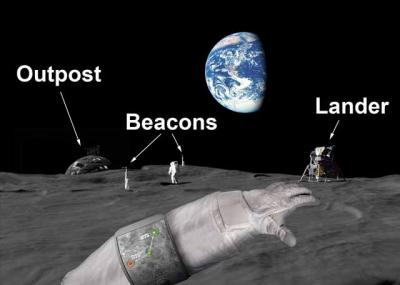
The Crazy Lune

 |
The Crazy Lune |
 |
|---|
      |
Digital Communication and Link Optimization Digital modulation:
A variety of modulation schemes could be chosen for this link; we elected to use simple QPSK digital modulation. This achieves a higher bitrate due to the addition of the quadrature channel while keeping the signal constellation simple for reduced BER.
The raised cosine pulse with a roll-off factor of 0.75 was chosen as the digital symbol. The raised cosine pulse minimizes intersymbol interference, enabling an optimal symbol period, thus maximizing the symbol rate. The raised cosine spectrum is shown below.
|
|
The symbol frequency is defined as
and the raised cosine symbol rate is
where the real bit rate for QPSK modulation is twice the symbol rate:
Using a rate 5/6 turbo code, the transmitted bit rate is then given as
Turbo code:
The introduction of turbo codes for forward error correction revolutionized convolutional codes and enabled links with performance far nearer to the Shannon channel capacity than ever before. Here we choose to use a turbo code designed for QPSK modulation that achieves near-errorless transmission (BER < 10-5) at an Eb/N0 within roughly 0.7 dB of the Shannon limit. (Acikel, O.F.; Ryan, W.E., "High rate turbo codes for BPSK/QPSK channels," Communications, 1998. ICC 98. Conference Record.1998 IEEE International Conference on , vol.1, no., pp.422-427 vol.1, 7-11 Jun 1998). This allows far lower CNR than would be possible for uncoded QPSK at the minimal cost of 20% overhead in transmitted bits.
Link design:
Our link was optimized according to the following procedure. An initial bandwidth and link distance were chosen. Using a raised cosine pulse, the specified bandwidth is used to calculate the transmitted bitrate as discussed above. Next, these parameters were used to determine the Shannon limit for Eb/N0, using the standard expression:
Since the CNR is related to Eb/N0 as
this expression can be substituted into the Shannon channel capacity equation, resulting in an expression of the Shannon Eb/N0 as a function of the channel bandwidth and bitrate:
Using the previous expression, the minimum Eb/N0 can be related back to the find the minimum CNR required for errorless transmission:
The previously determined noise power is used along with the threshold CNR to the minimum received power required for the link,
From the standard link budget equation, the minimum transmit power can now be calculated:
where
Finally, the Shannon channel capacity was calculated according to the expression given above. This was compared to the transmitted bitrate achieved by our design in order to evaluate its quality. Through the use of the turbo code and raised cosine pulses, this link is able to reach 89% of the Shannon limit for channel capacity.
|
Home | Project | Communication | Location | Power | Budget & Timeline Tuesday, December 8, 2009 © 2009 The Crazy Lune. All rights reserved. |